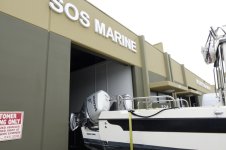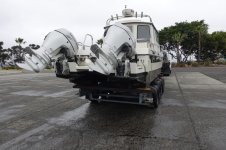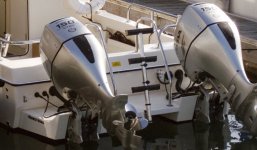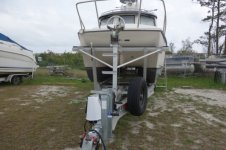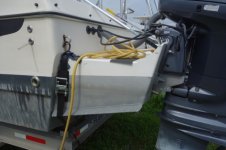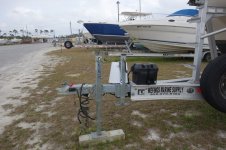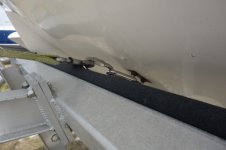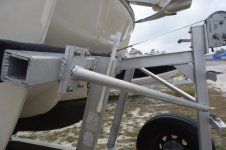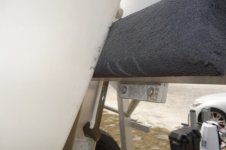Bob,
I own but haven’t used a 10k rated big ratchet gunnel strap because it interferes so much with getting into the cabin from the aft ladder at stops. We’re getting something out of the cabin (including lunch) at most every stop. Boarding my TC255 from the wheel fender is very difficult (even 8 years ago, when I was not overdue for knee replacements). Did you drill holes in the trailer I-beam, or just catch the frame on the strap hooks? The bowstop bolts and attachment points seem much more robust than the aft cleats (although I agree every bit helps). Plus the front safety chain resists the boat riding up and over the bowstop in a crash.
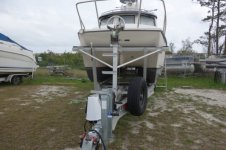
Tom,
I use HD rachet transom straps with a rag or plastic protectors and replace about every 3 years due to UV exposure and chafe on the bracket lower chine, which is hard to prevent.
https://www.amazon.com/BoatBuckle-HD-Ra ... 548&sr=8-2
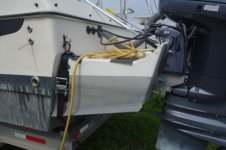
Some additional free TC255 trailering notes where you get what you pay for…
The EOH brake pump (now on my second one) contains a control circuit that is most commonly ruined by water intrusion. Best solution is having it in a protected battery box like Bob. Can’t do that, but I use a Walmart plastic waste basket secured by battery box hold downs, which I hope blocks some of the rain, at 60MPH that’s almost hurricane strength blowby.
My 1,100 lb tongue weight is a lot for a 1,500# jack and was a real workout to use. We added an 8,000# Fulton jack that is slower, but much easier to crank.
Mount your spare tire on a spare hub. Carry a min 6,000lb floor jack, 2x4 support pieces, penetrating oil and a breaker bar for your tire tool.
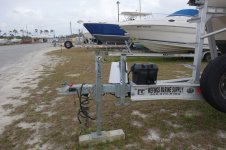
Our winch strap would chafe going over the bowstop, so I added two 10k links to prevent that.
Before heading down the launch ramp, remove the safety chain and let out about two feet of winch strap. If the boat slides back, there is too much tension on the winch to release it. When the front of the front fender is 1-2 inches underwater is about right, or awash on really steep and deep ramps.
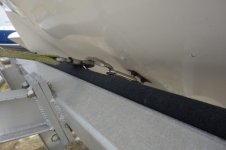
We trailer with the bimini Sunbrella removed and the frame secured to the rear. The frame is also secured to the railings with 75lb Ancor cable ties for extra stability. It is just barely possible to stash the whole frame inside the cabin, but not worth the effort, esp if you use the cabin as much as we do when trailering.
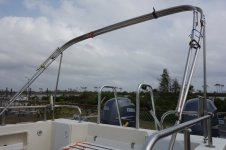
If you wire in a A TOAD CHARGER, it can keep the boat fridge from running down the boat batteries too much when trailering long distances. I’m not competent enough to ‘roll my own’ charging solution, but I installed this with only one short circuit, which the microprocessor controlled, a couple of fires and only one relatively minor explosion, so you could too if you want.
http://www.lslproducts.net/ToadChargePage.html
Credit for this find goes to Bob, as is so often the case (including my Wefings Float On trailer, which is a copy of Bob’s for his 2006(?) TC255).
The TC255 transom has a lot of weight cantilevered off the transom, and it should be fully supported by the end of the trailer bunks, not hanging off them. The bowstop can be adjusted a bit if needed for this without changing the tongue weight much.
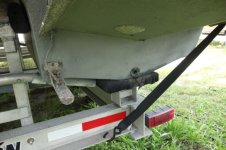
When loading a TC255 onto the trailer, it’s not possible to see where the bowstop is (even looking out the side window). I used an epoxy mount for a base of ½’ PVC pipe, and a a couple of 90 degree elbows to make an ‘indicator’ that I can see from the helm at the bow rail when the boat is at the bowstop. My helper-spouse and Ear-Tecs are good, but this visual reference is even better. It takes some throttle to get the TomCat moving up the bunks, and it’s easy to over-do it without the visual reference. The upper portion is too flimsy to trailer and is removed from the base epoxy mount for that.
Bowstop indicator mount:
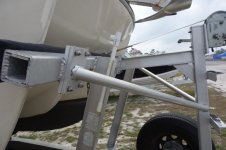
Bowstop indicator view from Helm:

After loading, the boat will no longer be at the bowstop. To slide it forward, at 2MPH walking speed on solid road, stomp the brakes and it will slide right into the bowstop cushion.
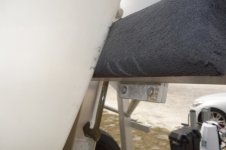
Happy Trailering, and hope this is helpful!
John

